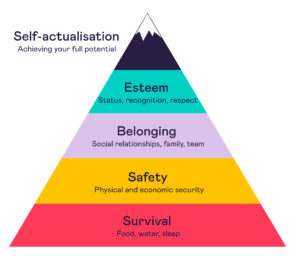We know you’ve heard of the five love languages because it’s a well-known framework that identifies ways we prefer to give and receive love. The five languages are used to communicate more effectively with your friends, family and partners as you consider their personal needs.
But did you know that you can actually apply these same principles to communicate appreciation and encouragement at work?
Maslow has discussed the idea of appreciation as part of the ‘esteem’ level of the pyramid of basic human needs. When we can’t find appreciation, we go and seek it elsewhere – simple as that. However, when we do feel appreciated, we thrive!

Appreciation is the cornerstone of employee engagement. With staff turnover at an all-time high for many businesses across the globe, leaders have every reason to ensure their employees feel appreciated. But how can they do it?
That’s where the five languages of appreciation come in, and it’s what we will be looking at in this article. Find out what they are and how employers can engage with this concept to increase engagement, productivity and retention.
What is employee appreciation?
Employee appreciation is the simple act of acknowledging employee contributions to your business and the workplace culture. There is even an entire day dedicated to employee appreciation every year on the first Friday of March, but don’t just wait for that one day a year. Appreciation should be a year-long practice!
Why is it important?
When things get busy, it can be easy to neglect employee appreciation. But this shouldn’t be the case; employee appreciation is essential. As a leader, you must go out of your way to show your team that you regularly appreciate them. After all, where would you be without them?
Appreciation can impact job satisfaction, workplace happiness and morale. When employees know their employer cares about them, it will boost motivation, increase engagement and productivity, and foster loyalty to reduce turnover.
The best thing about employee appreciation? It doesn’t cost anything. Showing appreciation for hard work on a project or outstanding results requires minimal effort, so why wouldn’t you make it a top priority?
The basics of employee appreciation
To help ensure you get it right, here are a few guiding principles when showing appreciation to your employees.
There is no one-size-fits-all approach to appreciation
One of the first things to understand when it comes to appreciating employees is that it’s not one-size-fits-all. It’s easy to default to the same actions for everyone, like sending a quick Slack message to say ‘thank you’ or tagging it at the end of an email. This is because we don’t know or haven’t thought much about what other options are available.
Create a culture of appreciation
You might be thinking recognition is best when it comes from managers. While it’s powerful and necessary, it’s also important to acknowledge everyone’s responsibility to create a culture of appreciation. Don’t just rely on managers, encourage and create opportunities for peer-to-peer recognition as well!
Make it impactful by communicating regularly and authentically
Don’t make appreciation something you check off your to-do list because employees can tell when you’re not being authentic. Employee appreciation is all about expressing genuine thanks and making your employees feel valued, and the best way to do that is in a consistent, authentic and personal way.
How to put the Five Languages of Employee Appreciation into practice
The five languages of appreciation concept come from the book “The Five Languages of Appreciation in the Workplace” by Gary Chapman and Paul White. As the title suggests, there are five main ways in which people communicate appreciation and employees will prefer and respond better to different languages. Here are the five languages and how you can put them into practice!
1. Words of affirmation
Some employees will appreciate the verbal acknowledgement that their work is appreciated. When a ‘thank you’ or ‘good job’ is sincere, it can be extremely powerful. Around half of employees prefer words of affirmation according to the authors, making it the most preferred language of appreciation. Here’s how to use words of affirmation most effectively:
Be specific
Saying ‘well done’ isn’t enough at times, appreciation and positive feedback are most effective when it’s specific. Describe the situation you’re referring to so the employee can understand the context of your situation clearly, then discuss the behaviour you’re praising. Next, highlight the impact of the person’s behaviour on you, the team and the company.
Be timely
We have said it before, and we will say it again, you want to be timely to ensure your words of affirmation have as much impact as possible. Why wait until an annual performance appraisal to say well done? Share it in real-time so the employee can associate the positive words with their specific actions.
Public and private praise
When it comes to praise, not everyone wants to receive it publicly. All you have to do is ask whether or not an employee is comfortable with being recognised on the company’s social media channel or whether they would rather it be more personal, like in a one-to-one.
Use an employee engagement software
Here at Mo, our employee engagement software allows you to focus on the moments that matter most. With Moments, you can share your praise publicly or privately on the platform and go one step further to boost your words of affirmation by rewarding in the moment.
2. Quality time
When your company culture is centred around teamwork, being available to one another fosters a culture of appreciation and belonging. Some employees enjoy spending time with each other both in and out of the office, but others will find value in one-on-one meetings and check-ins. Spending time with each other is also extremely important in a remote work environment and is essential for strengthening bonds.
For quality time, it’s important to remember that individuals’ preferences vary, and some people may not want to spend their evenings with colleagues. Here are a few ways in which you can infuse quality time into day-to-day work tasks:
Create learning opportunities
Expressing a desire to work with someone else can be a great way to learn from and connect with coworkers. Whether it’s gaining expertise on something through shadowing or receiving guidance from teammates, learning opportunities offer an excellent avenue for quality time.
Check-ins
As we said above, some employees may value check-ins and monthly meetings. Receiving undivided attention from leadership will significantly impact employees who prefer quality time.
Change up team meetings
When having an all-company call, how often do you ask, ‘Is there anything anyone would like to talk about?’. Yes, having status updates is extremely important, but asking that question creates a space for employees to share their thoughts and raise concerns.
Organise monthly socials
Working from home can be incredibly isolating for employees, especially those who value quality time. That’s why organising opportunities for the team to get together and have fun is essential, as those spontaneous Friday after-work drinks can’t happen when not in the office.
3. Acts of service
Employees will feel especially appreciated when someone reaches out to help them or ask for their help, as this communicates how vital their work is to the organisation.
In the workplace, acts of service can come in many different forms, such as helping someone complete a challenging piece of work or giving someone a helping hand to unload the office dishwasher.
Be careful with this one! When taking the time to help someone, don’t impose your own working style on them – take the time to understand how they work and do it their way. Also, don’t commit to something you aren’t able to help them complete without communicating that from the very beginning.
4. Tangible gifts
You might be surprised to hear that gifting only resonates with 6% of the workplace. Not to be confused with bonuses or pay rises, this language is the act of giving your employees a tangible gift that you know they will love and enjoy, based on their own personal interests.
Personalising the gift is a way of showing that you understand your employees, what they like and that you have listened to them. Gifts don’t always have to be in the form of a gift card. At Mo, we have partnered with Huggg, a gifting company which allows you to send a gift straight to the employee, whether it be a coffee in Caffè Nero or a bouquet of flowers.
This one requires a bit of background knowledge to be effective, take the time to get to know your employees and what they like – the last thing you want is to send a bottle of champagne to someone who doesn’t drink alcohol! If you use Mo, employees can set up a profile with their interests, which might give you an idea of what kinds of gifts they’d like to receive.
5. Physical touch
You won’t be surprised that physical touch is at the bottom of the languages of appreciation list. This language needs to be applied appropriately in the workplace. While you might feel comfortable hugging a colleague, you can’t assume everyone else is the same.
With this language, boundaries need to be respected. Take the time and show compassion for your employees and understand why they prefer not to have physical interactions with coworkers – it could be due to personal reasons or cultural differences.
Show your appreciation with Mo!
As people, we have a psychological need to feel appreciated and recognised for our contributions to work. As such, employers should strive to ensure we feel recognised and valued.
The five languages we have outlined above can be used to help demonstrate value to employees and increase happiness, engagement and productivity. If you want to increase the amount of happiness in your workplace, try Mo today.
Transform your culture with Mo

- Improve employee engagement scores
- Reduce employee churn
- Build a collaborative culture
Mo is an employee recognition and engagement platform that can help leaders improve collaboration and morale, reduce employee churn and drive change.
Our platform creates a vibrant culture by developing team habits, encouraging people to celebrate success, recognise results and appreciate colleagues.
Your complete toolkit for connecting and motivating teams in the new world of work. Book a demo with our team today!




